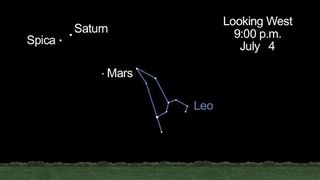See 4 Planets on Fourth of July! Jupiter, Venus, Mars and Saturn Shine

The two brightest planets in the night sky will kick off a July sky show early Wednesday (July 4) in a sort of celestial show-opener for the Fourth of July holiday in the U.S. Mars, Saturn and a nearly full moon will end the show at night.
The planets Venus and Jupiter will kick off their month-long sky show before sunrise on the Fourth of July, when the two planets will shine bright in the eastern sky, weather permitting, according to a NASA alert.
"Look out any east-facing window to see Venus and Jupiter, shining side-by-side, so close together you can hide them behind your outstretched palm," astronomer Tony Phillips explained in the NASA planet-gazing advisory. "It's a great way to start the day."
On July 4, Venus will appear to pass through the center of Hyades, a star cluster about 153 light-years from Earth, according to Phillips. In binoculars, Venus should appear as if it is surrounded by dozens of stars, he added. [Amazing Photos of Venus and Jupiter]
On the evening of July 4, the planets Mars and Saturn are visible in the western night sky, weather permitting. Saturn will shine above and to the right of the bright star Spica, with reddish-orange Mars appearing to the lower right of Saturn, near the constellation Leo, the Lion. Meanwhile, the moon will also appear bright all evening, just one day after reaching its full moon phase for the month.

By Saturday (July 7), the planetary arrangement will have changed. Venus and Jupiter will align with the bright star Aldebaran, which serves as the unblinking red eye in the constellation Taurus, the Bull.
"Together with Venus and Jupiter, it forms an almost perfect vertical line in the brightening dawn sky," Phillips said.
Get the Space.com Newsletter
Breaking space news, the latest updates on rocket launches, skywatching events and more!
On July 9, Venus and Aldebaran will appear so close they should form a spectacular pair, with Jupiter above them. The crescent moon will join the sky show on July 14, when it will be a slender arc that forms one point of a cosmic triangle with Jupiter and Venus, Phillips explained.
This isn't the first time this year that Venus and Jupiter have teamed up to offer a dazzling celestial display.
For several months at the beginning of 2012, Venus and Jupiter sparkled together in the evening sky as bright planetary pinpoints. Since then, the two planets have shifted into the morning sky.
If you snap an amazing photo of Venus and the moon, or Mars and Saturn, that you'd like to share for a possible story or image gallery, please send images and comments to managing editor Tariq Malik at tmalik@space.com.
You can follow SPACE.com Managing Editor Tariq Malik on Twitter @tariqjmalik. Follow SPACE.com on Twitter @Spacedotcom. We're also on Facebook and Google+.
Join our Space Forums to keep talking space on the latest missions, night sky and more! And if you have a news tip, correction or comment, let us know at: community@space.com.

Tariq is the Editor-in-Chief of Space.com and joined the team in 2001, first as an intern and staff writer, and later as an editor. He covers human spaceflight, exploration and space science, as well as skywatching and entertainment. He became Space.com's Managing Editor in 2009 and Editor-in-Chief in 2019. Before joining Space.com, Tariq was a staff reporter for The Los Angeles Times covering education and city beats in La Habra, Fullerton and Huntington Beach. In October 2022, Tariq received the Harry Kolcum Award for excellence in space reporting from the National Space Club Florida Committee. He is also an Eagle Scout (yes, he has the Space Exploration merit badge) and went to Space Camp four times as a kid and a fifth time as an adult. He has journalism degrees from the University of Southern California and New York University. You can find Tariq at Space.com and as the co-host to the This Week In Space podcast with space historian Rod Pyle on the TWiT network. To see his latest project, you can follow Tariq on Twitter @tariqjmalik.
